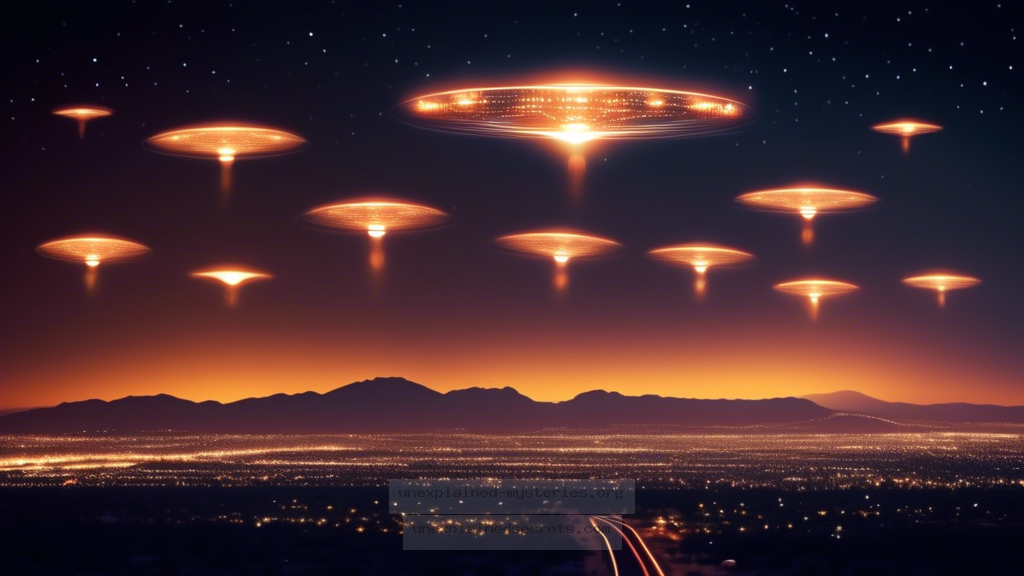What Really Happened During the Phoenix Lights Incident of 1997?
What Really Happened During the Phoenix Lights Incident of 1997?
The Phoenix Lights incident remains one of the most compelling and widely witnessed UFO sightings in history. On the night of March 13, 1997, thousands of people across Arizona reported seeing a series of strange lights moving across the sky, sparking intense debate and speculation about extraterrestrial life. This incident not only captivated the public but also raised questions about government transparency and the nature of unidentified flying objects. In this post, we will delve into the details of the Phoenix Lights, explore various theories and interpretations, and discuss the implications of this significant event in UFO history.
Historical Context of the Phoenix Lights Incident
The Phoenix Lights incident occurred during a time of heightened interest in UFOs and extraterrestrial phenomena. The late 1990s saw a surge in UFO sightings, fueled by media coverage and popular culture, including films and television shows. In Arizona, the incident took place against a backdrop of military activity, with the nearby Luke Air Force Base often linked to UFO sightings. The combination of public fascination and skepticism created a unique environment for the Phoenix Lights, making it one of the most analyzed UFO events of the era.
The incident itself unfolded over several hours, with witnesses observing a series of lights that appeared to form a V-shaped formation moving silently through the sky. Eyewitness accounts varied, with some describing the lights as solid crafts, while others saw them as orbs or beams of light. The sheer number of witnesses, estimated to be in the thousands, added credibility to the reports, and the event quickly became a focal point for UFO enthusiasts and skeptics alike.
Eyewitness Accounts: A Closer Look
One of the most compelling aspects of the Phoenix Lights incident is the sheer number of eyewitnesses. Reports came from a diverse group of individuals, including military personnel, police officers, and ordinary citizens. Many witnesses described the lights as being part of a large craft, while others noted their unusual movements and lack of sound. Some of the most notable accounts include:
- Governor Fife Symington: The then-governor of Arizona publicly dismissed the sightings as a hoax, only to later admit that he had witnessed the lights himself.
- Paul Hellyer: The former Canadian Minister of Defense stated that the lights were likely extraterrestrial in origin, aligning with his belief in the existence of UFOs.
- Local Residents: Many families reported seeing the lights and described their experience in detail, often expressing fear and amazement.
These firsthand accounts provide a rich tapestry of evidence, raising questions about the nature of what was observed that night. The consistency and detail across different testimonies lend credibility to the idea that something unusual occurred in the skies over Phoenix.
Core Concepts: Understanding the Phoenix Lights
The Phoenix Lights incident can be analyzed through various lenses, including the psychological, sociocultural, and scientific. At its core, the event raises fundamental questions about perception, belief, and the nature of reality. People often interpret unexplained phenomena through the frameworks of their own experiences and cultural narratives, leading to a wide array of interpretations.
From a psychological perspective, mass sightings such as the Phoenix Lights can be influenced by factors like social dynamics and collective consciousness. The phenomenon of “pareidolia,” where the mind interprets vague stimuli as familiar patterns (like seeing faces in clouds), may also play a role in how people perceive UFOs.
The Theories Behind the Lights
Several theories have emerged to explain the Phoenix Lights incident, ranging from mundane to extraordinary. These theories include:
- Military Flare Exercise: The U.S. military later claimed that the lights were flares dropped during a training exercise at the Barry Goldwater Range. Critics argue that the characteristics of the lights did not match those of flares.
- Extraterrestrial Craft: Many UFO enthusiasts believe the lights were part of an alien spacecraft visiting Earth. This theory is supported by the number of witnesses and the lack of sound during the sightings.
- Atmospheric Phenomena: Some scientists suggest that natural atmospheric phenomena may have caused the lights, though no definitive explanations have been proposed.
Each theory has its proponents, and the debate continues as new evidence and testimonies emerge. The lack of conclusive proof for any single explanation keeps the mystery alive and fuels ongoing interest in the incident.
Government Secrecy and Transparency Issues
The Phoenix Lights incident raises significant questions about government transparency regarding UFOs. In the years following the event, many advocates for disclosure have argued that the government is not forthcoming about its knowledge of UFOs and extraterrestrial life. The military’s initial dismissal of the incident as flares has been met with skepticism, particularly given the nature of the sightings and the volume of eyewitness reports.
In recent years, there has been a push for greater transparency regarding military encounters with unidentified aerial phenomena (UAP). The U.S. government’s release of previously classified information, including videos of UAP encounters, reflects a shift towards openness about these mysterious occurrences. However, the Phoenix Lights incident remains a pivotal case study in the ongoing debate about what the government knows and chooses to share with the public.
Common Misconceptions about the Phoenix Lights
There are several misconceptions surrounding the Phoenix Lights incident that can obscure understanding. Some of the most common include:
- All witnesses were confused or mistaken: While some skeptics argue that witnesses misidentified conventional aircraft or atmospheric phenomena, the sheer number and diversity of testimonies suggest otherwise.
- The incident was definitively explained: The military’s claim of flares does not account for all eyewitness accounts, leading many to believe that the true nature of the lights remains unexplained.
- UFO sightings are purely fictional: Dismissing all UFO sightings as hoaxes ignores the substantial evidence and credible witnesses associated with many cases, including the Phoenix Lights.
Addressing these misconceptions is crucial for fostering a more informed discussion about UFOs and encouraging open-minded exploration of the phenomena.
Investigating UFO Sightings: Best Practices
For those interested in investigating UFO sightings like the Phoenix Lights, several best practices can enhance the research process:
- Document Evidence: Collect as much information as possible from witnesses, including dates, times, and specific details of the sighting.
- Cross-Reference Accounts: Compare multiple eyewitness accounts to identify common patterns or discrepancies.
- Engage with Experts: Consult with scientists, astronomers, and UFO researchers to gain insights into potential explanations for sightings.
- Remain Open-Minded: Approach investigations with a willingness to consider various explanations, from the mundane to the extraordinary.
By following these practices, investigators can contribute to a more nuanced understanding of UFO phenomena and help separate fact from fiction.
Future Developments in UFO Research
As interest in UFOs and UAP continues to grow, future developments are likely to shed more light on incidents like the Phoenix Lights. Recent government initiatives, including the establishment of the UAP Task Force, signify a commitment to studying these phenomena more rigorously. Moreover, advancements in technology, such as improved surveillance systems and data analysis tools, may provide new insights into past incidents.
Public interest and advocacy for transparency will continue to drive research efforts, and as more civilians and scientists engage in this field, we may uncover new evidence that challenges existing narratives about UFOs and their origins.
Conclusion: The Enduring Mystery of the Phoenix Lights
The Phoenix Lights incident remains one of the most fascinating and discussed UFO sightings in history. With a multitude of eyewitness accounts, various theories, and ongoing debates about government transparency, the event has captivated the imaginations of both skeptics and believers alike. As we continue to explore the mysteries surrounding UFOs, the Phoenix Lights serve as a reminder of our enduring fascination with the unknown and the possibilities that lie beyond our understanding. Whether viewed as a military exercise, an extraterrestrial encounter, or an unexplained phenomenon, the Phoenix Lights will continue to inspire inquiry and debate for years to come.
Other Articles
Recent Posts
- What Happened to Flight MH370? The Conspiracy Theories That Still Haunt Us
- What Secrets Lurk Within the Walls of the Infamous Trans-Allegheny Lunatic Asylum?
- What Evidence Supports the Existence of Bigfoot in the Pacific Northwest?
- What Happened to the Indus Valley Civilization? Unraveling the Mysteries of Ancient Urban Life
- Can Telepathy Be Scientifically Proven Through Laboratory Evidence?







